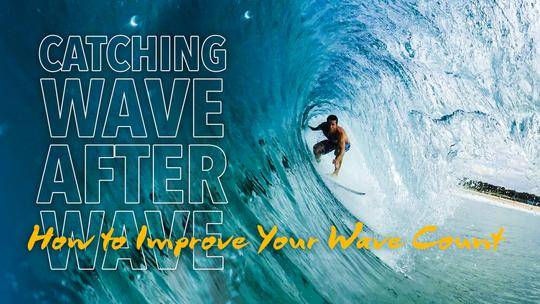You paddle out into a beautifully glassy sea with clean swell after clean swell rolling in. It’s the perfect day to catch and ride one head-high wave after another.
Now you’re out a couple of hundred feet from shore sitting on your board, waiting for your time to drop in. Suddenly, coming your way you see a wall of water rising, soon to crest.
You point your board toward the shore, lay on your stomach, stick your arms in the water, and begin cranking like Michael Phelps just challenged you to a race.
Yet, despite all the effort, another perfect swell to rolls right under you before you could pop up and drive into the pitch.
Few things are more frustrating than watching a clean break pass you right by.
To keep that from happening, try out these tips for upping your wave count and start shredding some killer gnar.
TRAIN FOR IT
Does your pop up resemble an elderly man getting out of bed in the morning? If you’re slow to get up on the board as you drive into the curl, you could easily be missing out on swell after swell.
In this case, it may be time to put in some work outside the water to improve your pop up time.
One of the best exercises for this is the classic, beloved burpee. This movement nearly mimics the range of motion that you follow through when popping up on a board.
Try this exercise two to three times a week to improve your wave count. You’ll begin to look less your grandfather waking up and more like a CrossFit games athlete as you see your pop up speed quickly increase.
LOWER GEAR HIGHER WAVE COUNT
Riding out into the water where you’ll be waiting for the right swell is not the same as when it comes time to drive into and drop in on the wave.
When you’re paddling out into the water, you’ll want to be using longer, slower strokes that help you efficiently glide through the water. Think of this as driving a car in a higher gear.
It’s a bit different though when catching a wave. In this case, you’ll want to prioritize torque over efficiency. This is when it’s time to drop into a lower gear.
Rather than taking long sweeping strokes, you’ll want to make shorter and quicker motions. This will drive you forward with greater control and speed in a short burst.
This little bit of extra forward burst could well be the difference between a perfect drop in and seeing the perfect wave’s crest roll under you once again.
GET LESSONS
There are plenty of minor and major adjustments you can make in your training and methods to improve your skill in catching waves. Still, one of the very best ways to up your wave count is to have an expert train you.
If you live in or will be spending time in the San Diego area and want to learn or simply improve your surfing, let us help you get one step closer to the next perfect drop in.
















